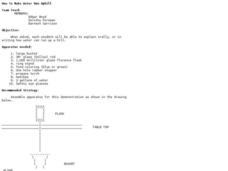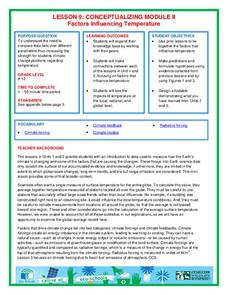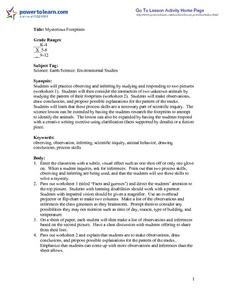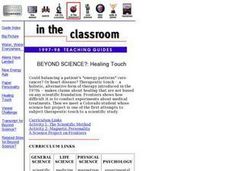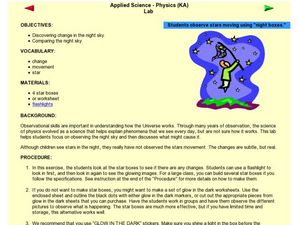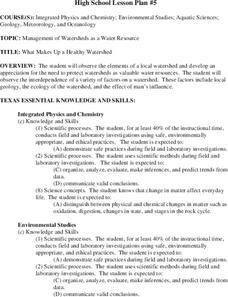Curated OER
The Atom Board-Making Atoms
For this making atoms science worksheet, students read about the atomic number of protons, finding the number of neurons, and how electrons function before they complete the atom board graphic organizer and respond to 4 short answer...
Curated OER
How to Make Water Run Uphill
Students observe science demonstration. In this science instructional activity, students watch an experiment showing water moving up from an area of higher concentration to an area of lower concentration, due to a change in atmospheric...
Curated OER
Leaf Observations
Second graders examine a variety of leaves. In groups or individually, they write down their observations on each leaf type and compare them to each other. To end the lesson, they share their observations with the class and draw the...
Curated OER
The Water Cycle
Fifth graders explore the major components of the water cycle. They pay close attention to evaporation, condensation, and precipitation. A water cycle kit is set up in the classroom, which learners observe for a couple of days before the...
Curated OER
Supernova Chemistry
Using spectroscopes, high school astronomy, physics, or chemistry learners observe emission spectra from several different sources. This stellar NASA-produced lesson plan provides terrific teacher's notes and a student handout. Make sure...
Science 4 Inquiry
Deforestation
Young scientists observe deforestation from satellite photos and discuss the importance of forests to the global environment. They then simulate a plot of forest when farmers move into the area over the course of seven years. Finally,...
Safe Drinking Water Foundation
Demonstration of Water Pollution
In this teacher-led demonstration, your young environmentalists will observe and record how different types of water pollutants look when they are combined. From here, individuals will develop a hypothesis on how the water can be...
Curated OER
Wild and Wetlands
Upper graders identify the major characteristics of a wetland. They explore the human factors that change a wetland and write a descriptive paragraph about wetlands. This comprehensive lesson also has an interactive "Watershed Game"...
Baylor College
Moving Air
In lab groups, young scientists place aluminum cans with a bubble-solution cap into different temperatures of water to see what size of bubble dome forms. As part of an atmosphere unit in preparation for learning about convection...
Consortium for Ocean Science Exploration and Engagement (COSEE)
Ocean Acidification: Whats and Hows
Open this lesson by demonstrating the production of acidic carbon dioxide gas by activated yeast. Emerging ecologists then experiment with seashells to discover the effect of ocean acidification on shelled marine organisms. They measure...
American Chemical Society
Why Does Water Dissolve Salt?
Individuals explore solubility by modeling how water dissolves salts. They then view a video and compare how well water and alcohol dissolve salts, relating their comparisons to the structure of each molecule.
National Wildlife Federation
When It Rains It Pours More Drought and More Heavy Rainfall
Which is worse — drought or flooding? Neither is helpful to the environment, and both are increasing due to climate change. The 16th lesson in a series of 21 covers the average precipitation trends for two different climates within the...
National Wildlife Federation
Conceptualizing Module II - Putting It All Together
"Creativity is just connecting things." - Steve Jobs. After weeks of researching climate change, the ninth lesson in a series of 21 combines the data and analysis to address essential questions. It covers natural phenomenon, human...
Curated OER
Dental Chemistry Analogy
After taking in background information on teeth, marble, eggshell, and fluoride, chemistry aces design an experiment. Their goal is to demonstrate whether or not fluoride has a similar effect on marble or eggshell as it does on tooth...
Curated OER
Mysterious Footprints
Students, after observing and responding to two pictures, consider the interaction of two unknown animals by examining the pattern of their footprints. They make observations, draw conclusions and propose possible explanations for the...
Curated OER
Beyond Science?: Healing Touch
Students apply the scientific method by building a "Proposal for Study." They label the Observation, Hypothesis, and Prediction columns. Students listen as the teacher introduces the alternative healing methods of therapeutic touch and...
Curated OER
Night Sky Observation
Students explore space science by completing an observational worksheet. For this astronomy lesson, students view several worksheets in which students identify minor changes between separate images in preparation for real star...
Curated OER
Hawaii's Freshwater Ecosystems
Students examine brackish water. In this Science lesson, students observe organisms found in brackish water. Students record their observations of the various organisms.
Curated OER
Science: Observing Fish Behavior
Students identify and explain various fish behaviors through observation. Over several months, they watch one fish in the classroom aquarium and record its behaviors in notebooks. They visit a virtual aquarium Website to find...
Curated OER
Weather Observation Journal
Young scholars record weather for a period of one month. In this weather lesson, students observe weather for one month on a large pictograph. Young scholars record clouds, wind, temperature and any other weather conditions they observe....
Curated OER
Summer Activities: The Wonders of Nature!
Students examine the world of nature. In this early childhood lesson plan, students develop observation skills as they bird-watch and make rainbows, experimentation skills as they explore seeds and carrots, prediction skills as they...
Curated OER
Life in a Drop of Pond Water
Students investigate living creatures that inhabit a pond and explore how various organisms satisfy their needs within their environments. For this life in a drop of pond water lesson, students examine microorganisms under...
Curated OER
Introducing the Use of Dichotomous Keys to Students
Students are introduced to the use of dichotomous keys as a simple means of beginning scientific observations in nature. They comprehend how to use a dichotomous key. Students distinguish characteristics of a group of organisms. They...
Curated OER
What Makes Up a Healthy Watershed
Students, after observing the elements of a local watershed, explore the need to protect watersheds as water resources for the future. They examine the factors involved with a watershed: geology, ecology, and the effect of man's...



